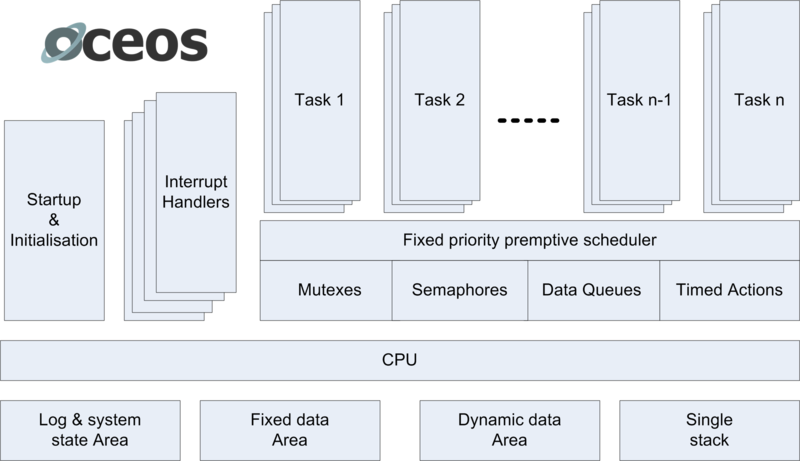Difference between revisions of "OCEOS/oceos introduction"
Okhoruzhyy (talk | contribs) |
Okhoruzhyy (talk | contribs) |
||
| Line 17: | Line 17: | ||
== <span style="color:#0000ff">OCEOS Main Features</span> == | == <span style="color:#0000ff">OCEOS Main Features</span> == | ||
*Fixed priority preemptive scheduling | |||
*Based on Stack Resource Policy – unbounded priority inversion, chained blocking, and deadlocks cannot occur | |||
*Deterministic processing | |||
*Fast real-time performance | |||
*Single stack rather than separate stack for each task | |||
*Small code footprint ( <10 kBytes for scheduling and mutex) | |||
*Inter-task communication (Counting Semaphores and Data Queues) | |||
*Synchronisation (Mutexes) | |||
*Task preemption level | |||
*Interrupt support (most of the directives can be called from IRQ handlers) | |||
*Very short time for disabling interrupts | |||
*Very low interrupt latency | |||
*Nested interrupts support | |||
*High precision timed actions (Software Timers) for data output and task start at pricise time | |||
*Supports SPARC V8 LEON2/3/4 and ARM Cortex-M single core targets | |||
*Fault Detection, Isolation and Recovety | |||
*GR716 Memory protection functionality | |||
*Enhancements for Cobham-Gaisler GR716 applications | |||
*Sample Applications for Quick start | |||
*Online Documentation | |||
*Tutorial applications to demonstrate main features of OCEOS | |||
*DMON debug tool support (execution timeline, CPU usage and profiling, commands to display information for OCEOS modules) | |||
*Support & ISVV services available from OCE Technology Ltd. | |||
*MISRA C Compliant | |||
*Developed to ECSS Category B and ISO 26262 standards | |||
*Developed in cooperation with European Space Agency (ESA) | |||
[[Category:backup]] | [[Category:backup]] | ||
Revision as of 10:37, 10 March 2022
Introduction and Main Concepts
OCEOS is a pre-emptive real time operating system (RTOS) with a small memory footprint intended for hard real time systems that use the GR716 micro-controller, SPARC LEON2/3/4 processors and ARM Cortex-M micro-processors.
It was developed by O.C.E. Technology with support from the European Space Agency (ESA) under project 4000127901/19/NL/AS and 4000135473/21/NL/GLC/js.
This document describes the features and use of OCEOS, and details its behavior and system calls.
Purpose of the Software
OCEOS is an object library for target architecture which provides directives to schedule fixed priority tasks, and supporting mutexes, semaphores, data queues, timed outputs, and interrupt handling.
There are also directives for logging, error handling, GR716 memory protection and GR716 watchdog control.
OCEOS Main Features
- Fixed priority preemptive scheduling
- Based on Stack Resource Policy – unbounded priority inversion, chained blocking, and deadlocks cannot occur
- Deterministic processing
- Fast real-time performance
- Single stack rather than separate stack for each task
- Small code footprint ( <10 kBytes for scheduling and mutex)
- Inter-task communication (Counting Semaphores and Data Queues)
- Synchronisation (Mutexes)
- Task preemption level
- Interrupt support (most of the directives can be called from IRQ handlers)
- Very short time for disabling interrupts
- Very low interrupt latency
- Nested interrupts support
- High precision timed actions (Software Timers) for data output and task start at pricise time
- Supports SPARC V8 LEON2/3/4 and ARM Cortex-M single core targets
- Fault Detection, Isolation and Recovety
- GR716 Memory protection functionality
- Enhancements for Cobham-Gaisler GR716 applications
- Sample Applications for Quick start
- Online Documentation
- Tutorial applications to demonstrate main features of OCEOS
- DMON debug tool support (execution timeline, CPU usage and profiling, commands to display information for OCEOS modules)
- Support & ISVV services available from OCE Technology Ltd.
- MISRA C Compliant
- Developed to ECSS Category B and ISO 26262 standards
- Developed in cooperation with European Space Agency (ESA)
